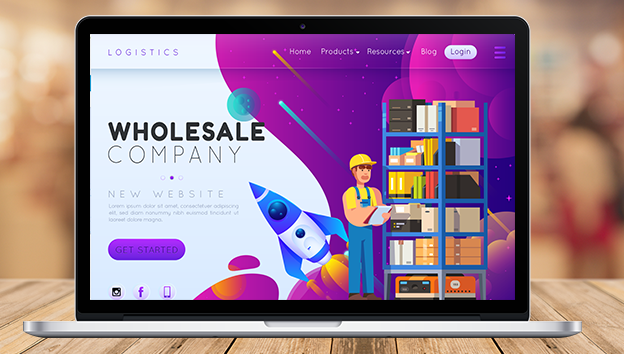How Wholesalers get on line
If you are a wholesaler, manufacturers or distributor you have watched the growing global ecommerce trend with a mix of both fear and longing. The idea that you can reach end users for your product is attractive. However most realise that this puts a strain between you and your trade customers. Why should they buy from you and compete with you at the same time?
This fear has meant that most of you have not taken the leap. The thing that most wholesale operators miss is that there is a bigger opportunity.
Ecommerce can be used to sell more of what you have to your trade customers.
This blog looks at the common challenges and roadblocks that Manufacturers, Wholesalers and Distributors face in joining the world of always on and always open for business. We will also discuss solutions that Dmac Media have implemented with customers in this sector to create profitable online presences.
When you talk to most suppliers, they will say customers have no time to talk to reps as the reason for slow growth in orders. If you consider your average small retail customer. They are bombarded day after day with customers, staffing issues, stocking issues and much more. On top of that they must manage accounts and payroll. When the sales rep stops by or calls, they have almost no time to talk. They just about manage to give the order and get back to their day. This limits the sales opportunity for the rep. If you were able to work with that retailer at a quieter time of day or better yet after they have locked up, you would find them far more receptive to looking at what options or offers you have for the month.
This is where ecommerce and more importantly searchable online catalogues have an edge. They are always there. Imagine a quick text message from a sales rep to say, “the new offers are now available online” Along with a handy link to the ordering page. That retailer can preview offers when wolfing down their daily lunch or while hiding from customers in the bathroom (no one does that! …right?)
Ok, I am sure you have imagined that exact scenario for your business already or something close to it, but you struggle with the following questions:
- How do I manage stock levels?
- How do I stop the general public seeing my prices?
- How do I make my pricing and discounts customer or volume specific?
- How do I manage invoicing and accounts?
- How do I get the reps on board?

So here is our take on these common questions:
1. How do I manage stock levels?
Do you have it in stock is by far the most common question for any distributor and in some cases a slow response can cost you a new account. By moving your stock online both existing or potential customers can see what products are in and out of stock. This can be handled one of two ways:
Connecting to Epos or Warehouse software.
Almost all inventory management systems have a web service feature built in or at the very least it is an option you can add to your software at a reasonable price. This allows you to send product stock and pricing info to your website on a regular basis (sometimes hourly) as well as receiving order data from the website so that stock is kept updated on both sides. Dmac have integrated with multiple Epos systems over the last decade and it is very rare to find a system that cannot offer this service. However, if you are a fan of good old Microsoft Excel or even a pen and paper system (Not kidding, I know you are out there) Then you should look at;
Manual File Uploads
A good website will give you product file import and export options. This allows you to upload a file (as often as required) to keep your stock in line.
2. How do I stop the general public seeing my prices?
This is an easy one. You can set your ecommerce website to display the recommended retail price for the general public or if there is no such price you can hide the price from public view all together. The real pricing is restricted to users that log in. You can control who gets an account for your website and that will keep out the random enquiries or tyre kickers.
3. How do I make my pricing and discounts customer or volume specific?
This is usually the show stopper for distributors as pricing can be very different depending on who you are dealing with. Customers that order small volumes do not get the same level of discount as the large volume customer. When they view your product ranges it is vital that they see their price.
The best way to manage this is to use a volume discount option which can be set for each individual product or product type so that the more a user orders the more favourable their price gets. On top of that you can also set customer specific prices so that when a customer logs in they can only see there pricing. Again, accounts and epos connections can be useful here but as discounts do not tend to change daily it is not crucial.
4. How do I manage invoicing and accounts?
Your ecommerce website will, by default, create an order delivery docket that is sent to both you and your customer. Many ecommerce sites use these to manually generate their invoices. For more automation we come back to that magic word, web services. Online accounts packages like Xero or big red book give you the option of automatically creating both purchase and sales invoices automatically via the website. Even older platforms like Sage & Exchequer now carry web service options. This kind of automation can cost but you will only need it if you are generating large volumes of orders through your website so if it is needed the budget should be there.
5. How do I get the reps on board?
This is a common concern when we are working with distributors and wholesalers as they believe reps will feel like the website is a replacement for their role. The reality is quite different. The sales rep’s job is to manage the account. The Ecommerce website makes it easier for that rep to generate more orders and garner more commission. Once they realise that they can make life easier for their customers they become a champion of the website rather than a detractor. In a lot of cases the sales rep has been demanding this very solution for years. Getting your sales team involved in the specification and development of the site will make it a lot easier to roll out to clients and give real world feedback on what the customers need.



 6 Things to Do Between Christmas & New Years
6 Things to Do Between Christmas & New Years An Introduction to Attribution
An Introduction to Attribution What exactly is a ‘landing page?’
What exactly is a ‘landing page?’